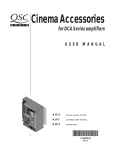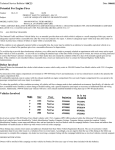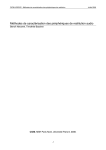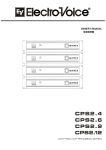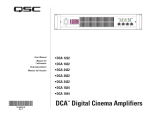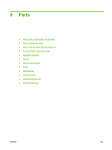Download QSC DCA Series User manual
Transcript
Film-Tech The information contained in this Adobe Acrobat pdf file is provided at your own risk and good judgment. These manuals are designed to facilitate the exchange of information related to cinema projection and film handling, with no warranties nor obligations from the authors, for qualified field service engineers. If you are not a qualified technician, please make no adjuatments to anything you may read about in these Adobe manual downloads www.film-tech.com Cinema Accessories for DCA Series amplifiers OFF ON USER MANUAL 1 2 3 4 PU SH 5 6 7 8 9 10 ▼ XC-3 Two-way crossover with delay ▼ LF-3 Low-frequency filter with delay ▼ SF-3 Subwoofer filter *TD-000079-00* TD-000079-00 Rev. A 1 © Copyright 1998 QSC Audio Products, Inc. All rights reserved. “QSC” and the QSC logo are registered trademarks, and “DCA” and “DataPort” are trademarks, of QSC Audio Products, Inc. 2 CINEMA ACCESSORIES FOR DCA AMPLIFIERS I. Introduction This manual covers setup and operation of cinema crossover accessories for QSC DCA Digital Cinema Amplifiers. These accessories comprise three models: the XC-3 crossover, the LF-3 low frequency filter, and the SF-3 subwoofer filter. Together with DCA amplifiers, they allow you to assemble any type of cinema sound system, mono or multi-channel. Each accessory mounts directly to the back of the amplifier, from which Ch. 1 LF full-range audio audio plein registre Vollbereichaudio audio de gama llena XC-3 HF 2-way crossover it also draws its power. It has its own input and, if necessary, output DCA amplifier Ch. 2 the amp through its DataPort. Using the XC-3 in a simple two-way system. In many speaker systems, a passive mid/high combination will handle the higher frequencies, creating essentially a three-way system. XC-3 HF 2-way crossover Frequency and delay parameters are user adjustable by inserting selected 8-pin SIP resistor networks (included with each unit) into sockets on the underside of the accessory. A DIP switch permits Ch. 1 MF full-range audio audio plein registre Vollbereichaudio audio de gama llena connectors. A male HD-15 connector conveys the audio signals into DCA amplifier selection of functions such as delay and high-frequency boost. Ch. 2 II. Description of Functions L XC-3 Ch. 1 LF LF-3 low-frequency filter LF band fed to channel 1 of the amplifier and the high frequencies DCA amplifier to channel 2. An all-pass filter on the low frequency band delays Ch. 2 the audio signal, permitting time alignment of a cone driver R full-range audio audio plein registre Vollbereichaudio audio de gama llena This accessory is a two-way crossover, with the low frequency with a high-frequency horn. A selectable high-frequency boost circuit provides several increments of compensation for screen loss or constant-directivity horn equalization. A HF trim control Ch. 1 MF XC-3 HF 2-way crossover provides 0 to 20 dB of attenuation for matching levels DCA amplifier between frequency bands. Ch. 2 Using the XC-3 and LF-3 in a stereo three-way system The XC-3 can be used by itself with one amplifier for a 2-way system (shown top left), or with the LF-3 and an additional amplifier for 3-way systems, as shown at left. The XC-3 has a pass-through output in parallel with the input for distributing the audio signal to the LF-3. The filter circuitry uses a 4th- Ch. 1 SF-3 order Linkwitz-Riley alignment with 24 dB/octave slopes. DCA amplifier subwoofer filter Ch. 2 LF-3 Used in a system with the XC-3, the LF-3 performs the lowfrequency crossover functions in a 3-way system as shown at left. Unlike the XC-3, though, it is a device with two discrete Using the SF-3 with a discrete subwoofer channel channels; one LF-3 with an amplifier will support two other amplifiers with two XC-3 accessories, as shown. The 4th-order Linkwitz-Riley low-pass filters have 24 dB/octave slopes. 3 Each channel also has an all-pass filter providing delay for time alignment. Frequency and delay parameters for both channels are set individually, although in all but a few applications they would be set the same. Each channel also has a trim control providing 0 to 20 dB of attenuation to facilitate matching levels among the various frequency bands. SF-3 This subwoofer filter accessory has two summed inputs and a bandpass filter that defines the frequency range of the subwoofer program. The frequencies of the 2nd-order high-pass and 4th-order Linkwitz-Riley low-pass filters are both user-defined. The high-pass filter also has a switchable low-frequency boost feature: switched on, it provides a 6 dB bump at the selected high-pass frequency, useful for extending the low-end response of some speaker systems; off, the response is a flat Butterworth curve that is 3 dB down at the selected frequency. The output is parallel, feeding the same signal into both channels of the amplifier. The SF-3 has no delay function. A level trim control provides 0 to 20 dB of attenuation. The SF-3 can be used to derive subwoofer-range program from full-range audio, or it can be used with a discrete subwoofer channel in cinema sound systems. III. Configuring the accessories Configure each accessory before you mount it to the amplifier. If an accessory is already mounted to an amplifier, always turn the amp off before changing switch settings or input or output connections, or detaching the accessory. Use the tables on the following pages to determine the correct resistance for the desired frequency and delay settings. Use the diagram at the top of the opposite page to identify the values of the resistor networks. A +10 dB flowchart for each model will assist you in setting the various parameters, +5 dB fHP fXO +2.5 dB 2-way and the chassis label on each accessory also details the correct DIP switch +7.5 dB settings. An appendix in the back of this manual lists manufacturer- XC-3 3-way recommended crossover frequency and delay settings for various popular cinema speaker systems. LF delay The purpose of the delay functions in the XC-3 and LF-3 is to correct for time misalignments between different types of speaker driver in the overlap region between adjacent frequency bands. These time misalignments occur when fXO the acoustical source points of the drivers for the adjacent frequency bands are physically at different distances from the listener(s). A delay compensation LF-3 of 1 millisecond represents approximately 1.13 ft (13.5 in), or 34.4 cm. NOTE: Even if you don’t use a particular filter or delay feature on an accessory, put an unused SIP resistor network of any value into its socket to ensure circuit stability when it is powered up. The SIP resistor networks have no polarity and therefore do not need to be Delay LF boost fHP fLP inserted in a certain direction. Make sure all eight pins are inserted properly Low pass filter off into the sockets holes, and then gently but firmly press the network into the socket until it is fully seated. If a SIP resistor network is difficult to remove SF-3 LF flat Low pass filter on with your fingers, use a small screwdriver, prying gently first at one end of the SIP and then the other, until it is loose. 4 Configurable functions of the three accessory models Crossover freq. (fXO) SIP resistor value Delay (ms) SIP resistor value 80 Hz 68K 1.8 27K 150 Hz 39K 1.4 22K 200 Hz 27K 1.3 20K 250 Hz 22K 1.2 18K 300 Hz 20K 1 15K 350 Hz 18K 0.8 12K 400 Hz 15K 0.7 10K 500 Hz 12K 0.6 8.2K 600 Hz 10K 0.5 6.8K 650 Hz 8.2K 0.4 5.6K 800 Hz 6.8K 0.3 4.7K 1 kHz 5.6K 1.2 kHz 4.7K 1.5 kHz 3.9K RESISTANCE 2.7K 3.9K 4.7K 5.6K 6.8K 8.2K 10K 12K 15K 18K 20K 22K 27K 33K 39K 47K 56K 68K Use only these three digits to determine resistance code. Disregard the other numerals and letters. Use these tables with the XC-3 and LF3 to determine the correct resistor values for the crossover frequencies and delays you need. The shaded values are for the LF-3 and the highpass frequency (fHP) of the XC-3). CODE 272 392 472 562 682 822 103 123 153 183 203 223 273 333 393 473 563 683 Identifying SIP resistor networks Setting up the XC-3 This procedure involves setting the DIP switches, as well as selecting 1 and inserting SIP resistors into the appropriate sockets. Set switches 2, 9, and 10 to ON. The flowchart on the next page takes you through OFF ON 1 2 3 4 5 6 7 8 9 10 all the steps necessary before mounting the accessory to the amp. 1 The illustration on the next page shows the locations of the sockets for the SIP resistor networks. The resistor networks have no polarity or directionality and therefore do not need to be inserted in any particular way, as long as each network pin goes into its own hole in the socket. XC-3 controls and switches Use the tables at the top of this 10 page to select the correct resistor 9 networks for the settings you need. 7 The SIPs supplied with the XC-3 provide a selectable frequency range for fXO of 80 Hz to 1.5 kHz, and delay settings from 0.3 to 1.8 milliseconds, plus bypass (no delay); HF boost = 10 dB 8 HF boost = 7.5 dB 6 5 HF boost = 5 dB 4 3 2 HF boost = 2.5 dB 1 0 HF boost = OFF -1 -2 -3 -4 -5 contact QSC’s Technical Services department if your application requires different settings. -6 500 700 1k 2k 3k 4k 5k 6k 7k 8k 9k10k 15k 20k 30k 40k 50k Effects of high frequency boost on frequency response (crossover frequency = 500 Hz). A boost of +10 dB is most common for compensating for screen loss (attenuation of high frequencies as sound passes through screen perforations) and for constant-directivity horns. 5 J1 (fXO) 3-way 2- or 3-way? 2-way Switches 7 & 8 = OFF Switches 7 & 8 = ON Select fXO ; install appropriate SIP in J1 Select fXO and fHP ; install appropriate SIPs in J1 (f XO ) and J7 (fHP ) Install SIP (any value) in J7* Need LF delay? No Yes Switch 1 = OFF Switch 1 = ON J2 (LF delay) Install SIP (any value) in J2* J7 (fHP) Select delay; install appropriate SIP in J2 Locations of SIP sockets on the XC-3 Need HF boost? When using the XC-3 in a three-way system in conjunction with the LF-3, the lower frequency (fHP) should match the crossover frequency of the LF-3 (fXO). The SIPs supplied with the XC-3 allow a selectable frequency range for fHP of 80 to 500 Hz. FACTORY SIP SETTINGS fXO 500 Hz (12K SIP resistor in J1) LF delay 1.8 ms (27K SIP resistor in J2) f HP 80 Hz (68K SIP resistor in J7) FACTORY SWITCH SETTINGS Bi-amp mode (switches 7 & 8 = ON) LF delay active (switch 1 = ON) HF boost defeated (switches 3 through 6 = OFF) Switches 2, 9, & 10 = ON RECOMMENDED AMPLIFIER SETTINGS WITH THE XC-3 Clip limiters ON, both channels Stereo mode High-pass filter ON, both channels High-pass frequency 30 or 50 Hz, both channels 6 10 dB (CD horn) Yes No 7.5 dB Switches 3–6 = OFF 2.5 dB Switch 3 = ON; Switches 4–6 = OFF Switch 6 = ON; Switches 3–5 = OFF 5 dB Switch 4 = ON; Switches 3,5, 6 = OFF Switch 5 = ON; Switches 3,4, 6 = OFF *To ensure circuit stability Attach to amplifier Setup flowchart for the XC-3 Setting up the LF-3 J8 (Ch. 1 fXO) J1 (Ch. 1 delay) This procedure involves setting the DIP switches, as well as selecting and inserting SIP resistors into the appropriate sockets. Set switches 2 and 4 through 9 to OFF, and switch 3 to ON. The flowchart below takes you through all the steps necessary before mounting the accessory to the amp. The LF-3 is typically used in a system in conjunction with the XC-3 crossover. For example, a stereo three-way system will require three DCA amplifiers, two XC-3 cinema crossover accessories, and one LF-3 lowtypical input signal is full-range audio taken from the male ON 1 2 3 4 5 6 7 8 9 10 OFF frequency cinema accessory, as shown on page 2. The J6 (Ch. 2 fXO) XLR connector labeled “OUTPUT (TO LF-3)” on the XC-3. The illustration to the left shows the locations of the sockets for the SIP resistor networks. The resistor net- J2 (Ch. 2 delay) works have no polarity or directionality and therefore do Locations of SIP sockets on the LF-3 not need to be inserted in any particular way, as long as LF-3 controls and switches each network pin goes into its own hole in the socket. Select fXO for Ch.1 and Ch. 2; install appropriate SIPs in J8 (Ch. 1) and J6 (Ch. 2) Use the tables at the top of page 5 to select the correct resistor networks for the crossover frequency (fXO) and delay settings you need. The SIPs supplied with the LF-3 provide a range of frequency selections from 80 Hz to 500 Hz, and delay settings from 0.3 to 1.8 No Need LF delay? milliseconds plus bypass (no delay); contact QSC’s Technical Services department if Yes Channel 1: Switch 10 = ON Channel 2: Switch 1 = ON Switches 1 & 10 = OFF Install SIPs (any value) in J1 and J2* Select delay for Ch.1 and Ch. 2; install appropriate SIPs in J1 (Ch. 1) and J2 (Ch. 2) Attach to amplifier your application requires different settings. When using the LF-3 in a three-way system in conjunction with the XC-3, the crossover frequency of the LF-3 (fXO) should match the lower high-pass frequency (fHP) of the XC-3. In most circumstances, the LF-3 would be used with an amplifier in stereo mode. But if two amp channels are needed for one low frequency signal, you can use the Channel 1 input *To ensure circuit stability Setup flowchart for the LF-3 of the LF-3 and parallel the inputs of the amplifier (using the amp’s DIP switches). FACTORY SIP SETTINGS fXO 350 Hz, both channels (18K SIP resistor in J6 & J8) Delay 1.4 ms, both channels (22K SIP resistor in J1 & J2) FACTORY SWITCH SETTINGS Delay active, both channels (switches 1 & 10 = ON) Switches 2 and 4 through 9 = OFF; switch 3 = ON RECOMMENDED AMPLIFIER SETTINGS WITH THE LF-3 Clip limiters ON (both channels) Stereo mode; parallel mode in applications requiring dual LF amp channels with one source High-pass filter ON (both channels) High-pass frequency 30 or 50 Hz, depending on speaker (both channels) 7 Setting up the SF-3 This procedure involves setting the DIP switches, as well as selecting and inserting SIP resistors into the appropriate sockets. First, set switches 1 through 6 and 10 to OFF. The flowchart on the opposite page takes you through all the steps necessary before mounting the accessory to the amp. OFF ON 1 2 3 4 5 6 7 8 9 10 The bottom right illustration details the locations of the two SIP sockets used on the SF-3. The resistor networks have no polarity and therefore do not need to be inserted in any particular way, as long as each pin goes into its own hole in the socket. The mono subwoofer program can be derived from summing and filtering stereo or mono full-range audio, or it can come from a discrete mono subwoofer channel, such as in a 5.1, 6.1, or 7.1 cinema surround system. If the subwoofer program is to be derived, use the SF-3’s low-pass filter to set the SF-3 controls and switches high end of the subwoofer passband. If the subwoofer program source is a discrete channel, as in most cinema systems, we recommend that you bypass the low-pass filter. The SF-3’s two inputs are summed together, so you can use one or both, depending on your system Low-pass freq. (fLP) SIP resistor value needs. The outputs to the two amplifier channels are monaural and in parallel, unlike the XC-3 and 80 Hz 68K LF-3. Thus, SF-3 is the only DCA accessory that can be used with the amplifier in bridged mono mode, 150 Hz 39K when necessary. 250 Hz 22K Use the table at right to select the correct resistor networks for the SF-3’s filter frequency settings. High-pass freq. (fHP) SIP resistor value An identification chart for SIP resistor networks is on page 5. The SIPs supplied with the LF-3 provide 20 Hz 47K a selection of three low-pass frequencies: 80, 150, and 250 Hz; and six high-pass frequencies from 25 Hz 33K 20 to 50 Hz. Use the speaker manufacturer’s recommended filter settings. 30 Hz 27K 35 Hz 20K 40 Hz 15K 50 Hz 10K The low-frequency boost switch selects the Q of the high-pass filter: 0.707 for flat (Butterworth), or 2 for “boost,” which adds a 6 dB peak at the filter’s selected frequency. Some speakers require this boost to extend the low-frequency response. FACTORY SIP SETTINGS f HP 30 Hz (27K SIP resistor in J2) f LP 250 Hz (22K SIP resistor in J1 & J2) Use this table to determine the correct resistor values for the SF-1 filter frequencies. FACTORY SWITCH SETTINGS Low-pass filter OFF—”cinema” setting (switches 7 & 8 = ON) LF flat (switch 9 = OFF) Switches 1 through 6 and 10 = OFF J6 (fLP) RECOMMENDED AMPLIFIER SETTINGS WITH THE SF-3 Clip limiters ON (both channels) Stereo or bridged mono mode, as the application dictates High-pass filter OFF (both channels) J2 (fHP) Locations of SIP sockets on the SF-3 8 high- lowpass pass Derived by filter highpass Is subwoofer program derived or discrete? Turn low-pass filter on Switches 7 & 8 = OFF Turn low-pass filter off Switches 7 & 8 = ON Select high-pass freq. (fHP); install appropriate SIP in J2. Select low-pass freq. (fL P); install appropriate SIP in J6. Select high-pass freq. (fHP); install appropriate SIP in J2. No From discrete subwoofer channel Install SIP (any value) in J6* Need LF boost? Switch 9 = OFF Yes Switch 9 = ON Attach to amplifier *To ensure circuit stability Setup flowchart for the SF-3 IV. Mounting the accessories An accessory may be mounted with the amplifier either in or out of the rack, even if the amp is installed with rear rack ears. 1. Turn off the amplifier before installing the accessory. 2. Make sure the SIP resistor networks are installed properly and no SIP sockets are empty. 3. Line up the HD-15 connector on the accessory with the amplifier’s DataPort, then press the accessory onto the back of the amplifier so that the HD-15 connector inserts into the DataPort. 4. Use the three screws supplied to secure the accessory to the amplifier chassis, as shown at left. Two long screws go into the holes near the DataPort, while the short screw goes through the hole in the tab on the right edge of the accessory. Do not overtighten the screws. 5. Attach the input and output cables to the appropriate connectors on the accessory. Use the amplifier’s normal output connectors for attaching speaker and monitor cabling. 9 V. Setting up the DCA accessories in the cinema sound system Setting up the DCA accessories in the B chain of the cinema sound system primarily involves setting the trim levels on the XC-3, LF-3, and SF-3. This requires the pink noise source in the cinema processor and a real-time acoustical spectrum analyzer. 1. Set up the analyzer microphone in the center of the cinema audience seating area or in another recommended location. 2. Set the gain controls wide open for all the DCA amplifiers, and check the HF boost settings on the XC-3 accessories. 3. Apply a pink noise test signal from the cinema processor to the left channel XC-3 input. Watch the frequency response on the analyzer and use the HF trim control on the XC-3 and the LF trim on the LF-3 to balance the levels of their frequency bands to that of the the mid-frequency band, within specifications. If the shape of the HF response is not correct, use a boost setting that better corrects the deficiency; turn the amplifiers off before changing the switch settings. 4. Repeat this process for the center and right screen channels and any surround channels that are bi- or tri-amped. 5. Follow the processor instructions for setting sound pressure level outputs of all the channels, including the subwoofer. If you are unable to obtain a satisfactory frequency response or SPL on a channel, carefully check the wiring and connections. Some likely causes are reversed speaker polarity on one or more drivers; loose or broken wiring or connections; or blown or damaged speaker drivers. DCA 2 Left MF Left HF DCA LF-3 1 DCA 1 XC-3 L C 5.1 Cinema R Processor LS RS Sub XC-3 1 2 Center MF Center HF 2 DCA LF-3 1 DCA XC-3 1 2 Right MF Right HF 2 SF-3 1 2 Right LF Spare DCA 1 DCA Left LF Center LF 2 Sub Sub Left Surround Right Surround A typical 5.1 surround system with DCA amplifiers and accessories 10 APPENDIX Crossover and delay settings for popular cinema loudspeaker systems Consult your speaker documentation. Some data has not yet been determined. Also, the high-frequency horn of some of the systems listed have multiple mounting positions, so the desired delay settings will depend on the positioning chosen. Check the QSC website (http://www.qscaudio.com) for information updates. Brand JBL Model Crossover frequency (Hz) Delay (ms) 4675C 500 1.8 4670D 800 0.7 3678 1K 0 TS9040D-LX 500 1.8 TS550D-LX 500 1.8 TS550DMT-LX 500 1.8 TS940D 500 TS992-LX 1.2K 0 TS993-C 400 0 Variplex-B 350 LF: 1.4 Variplex 350 & 1.5K LF: 1.4 KPT-940.L 500 1.2 KPT-904.M 800 0.3 CB2591 500 CB2592 500 CB259 500 CB152 1200 CB153 350 CB523 300 Electro-Voice Klipsch EAW Martin Audio MC 4973 300 & 1.8K MC 4973B 300 MC 4953 300 & 1.8K MC 4953B 300 Screen 4 650 11 © Copyright 1998 QSC Audio Products, Inc. All rights reserved. “QSC” and the QSC logo are registered with the U.S. Patent and Trademark Office. QSC Audio Products, Inc., 12 1675 MacArthur Boulevard Costa Mesa, California 92626 USA PH: (714) 754-6175 FAX: (714) 754-6174













